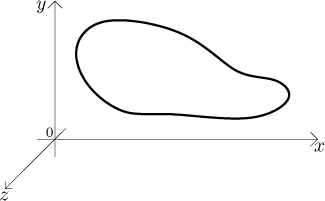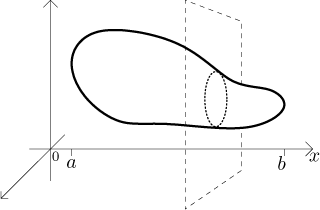
Consider a solid in the three-dimensional space.

To find its volume, we will try our trick with slicing. For some x, consider a tiny interval of size dx. If we look at the points of the solid whose x-coordinates fall into this interval, we obtain a really thin slice. Since this slice is so thin, we may ignore the curving of its edges and imagine it as a flat object carved out of a sheet, which means that its volume will be the area times the thickness dx.

If we add all these volumes, we get the whole volume. Of course, it is
enough to add just slices that intersect the solid. Mathematically, for
every x, we slice the given solid with the plane perpendicular to the
x-axis and intersecting it at the point x. We assume that we
can find the area of this slice, call it
![]()
Of course, this is far from a general procedure for finding a volume. This
procedure only works if the solid is nice enough, then we can determine the
areas
It should be noted that we can of course also slice with planes perpendicular to the other axes, in which case we would integrate with respect to the corresponding variable. In fact, the slicing planes need not to be even perpendicular, it is enough that they be parallel; in some problems it is preferable to use oblique slices.